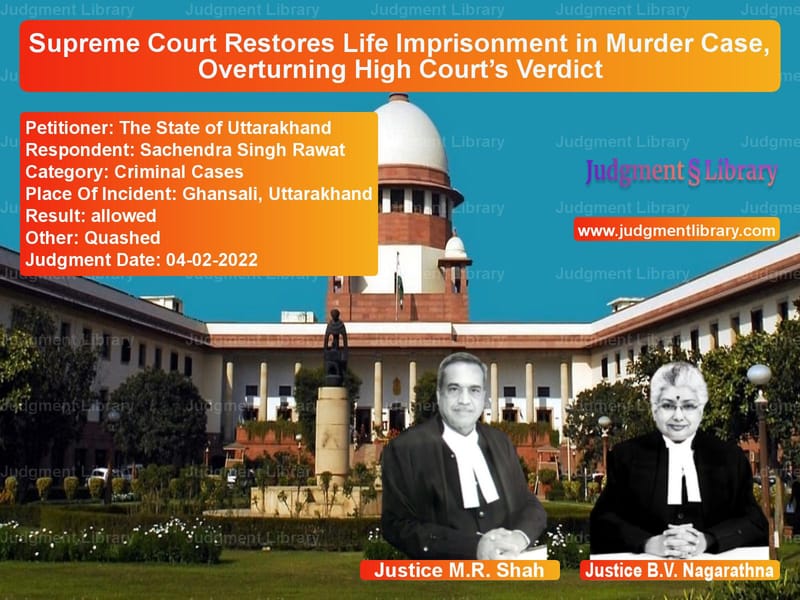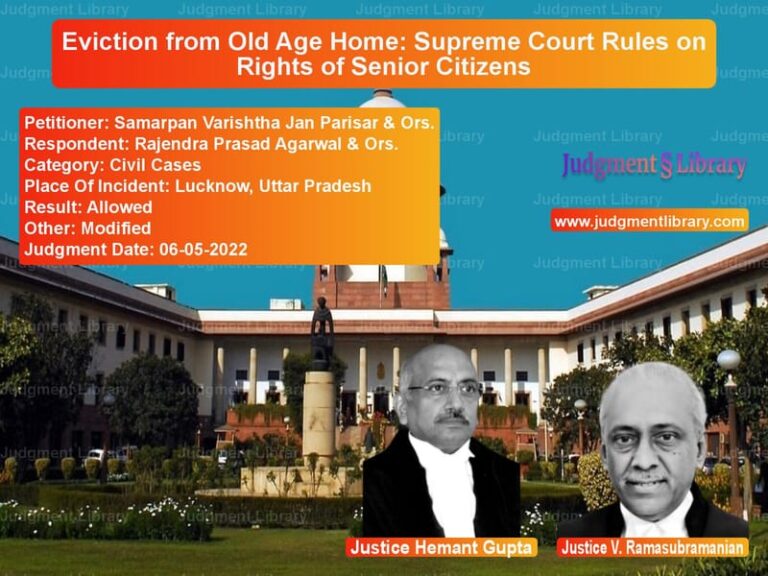Supreme Court Restores Life Imprisonment in Murder Case, Overturning High Court’s Verdict
The Supreme Court, in The State of Uttarakhand vs. Sachendra Singh Rawat, delivered a crucial judgment regarding the correct interpretation of murder under Section 302 of the Indian Penal Code (IPC). The case involved the brutal killing of Virendra Singh and raised significant legal questions about whether the offense amounted to murder or culpable homicide not amounting to murder.
Background of the Case
The incident took place on 26 November 2014 in the village of Ghansali, Uttarakhand, during the Mehendi ceremony of one Anil. The entire village, including the accused, Sachendra Singh Rawat, and the victim, Virendra Singh, participated in the event. An altercation occurred between the two, but the villagers intervened, preventing any further escalation.
Later that night, around midnight, the accused attacked Virendra Singh with a rough piece of wood (‘Phakadiyat’), hitting him on the head multiple times. The victim ran towards his house for safety, but the accused chased him and continued the assault in front of his house. The victim sustained severe head injuries, including a skull fracture. His wife, Darshani Devi, and his mother, Geeta Devi, attempted to intervene but failed.
Virendra Singh was initially taken to a local doctor in Ghansali and later referred to Mahant Indresh Hospital in Dehradun, where he succumbed to his injuries on 5 December 2014. His wife lodged an FIR against the accused, leading to his arrest and subsequent trial.
Arguments by the Parties
Prosecution’s Arguments (State of Uttarakhand)
- The accused used a heavy wooden stick (‘Phakadiyat’) and repeatedly struck the victim’s head, indicating an intent to kill.
- The attack did not occur in the heat of passion but was a deliberate act of aggression.
- The High Court wrongly concluded that the case fell under Exception 4 to Section 300 IPC, reducing the charge from murder to culpable homicide not amounting to murder.
- The accused chased the victim to his house and continued the attack, showing clear intention and premeditation.
- The multiple blows to the head caused fatal injuries, leading to the victim’s death.
Defense’s Arguments (Sachendra Singh Rawat)
- The incident was a sudden fight that occurred in the heat of passion during the Mehendi ceremony.
- The weapon used was not a lethal weapon but a rough wooden stick.
- There was no prior enmity or premeditation, and the act was spontaneous.
- The case should be classified under Exception 4 to Section 300 IPC, which allows a reduction in punishment if the act occurs in the heat of passion upon a sudden quarrel.
Supreme Court’s Key Observations
1. The Attack Was Not a Sudden Fight
The Supreme Court rejected the High Court’s finding that the killing resulted from a sudden fight in the heat of passion. The Court observed:
“The first altercation took place during the Mehendi ceremony and was diffused by the villagers. The second incident, where the accused attacked the deceased at midnight, cannot be said to have taken place in the heat of passion.”
2. Multiple Blows to the Vital Parts of the Body
The Court highlighted the nature of the injuries, stating:
“The accused struck multiple blows on the head, causing a skull fracture and brain injuries. The severity of the injuries and their location clearly indicate an intent to kill.”
3. Application of Exception 4 to Section 300 IPC
The Court ruled that the case did not fall under Exception 4 of Section 300 IPC, which applies when an act is committed in the heat of passion during a sudden fight:
“The accused chased the victim to his house and continued the assault. There was sufficient time for the accused to reconsider his actions, ruling out the possibility of a sudden fight.”
4. Previous Supreme Court Judgments on Similar Cases
The Court cited several precedents to support its decision:
- In Stalin vs. State (2020), the Court ruled that repeated blows on a vital part of the body indicate an intention to kill.
- In Virsa Singh vs. State of Punjab (1958), the Court held that if an injury is sufficient to cause death in the ordinary course of nature, the intention to kill can be presumed.
Final Judgment
The Supreme Court ruled as follows:
- The appeal by the State of Uttarakhand was allowed.
- The High Court’s decision reducing the sentence to ten years of rigorous imprisonment was set aside.
- The accused, Sachendra Singh Rawat, was convicted under Section 302 IPC and sentenced to life imprisonment.
Impact of the Judgment
This ruling has significant implications for criminal law interpretation:
- Reaffirms the distinction between murder and culpable homicide: The judgment clarifies when Exception 4 to Section 300 IPC applies.
- Upholds the importance of intent: Multiple blows to a vital part of the body indicate intent to kill.
- Ensures stricter sentencing for violent crimes: The ruling prevents courts from reducing sentences in cases where clear intent is established.
- Strengthens legal precedent: The case aligns with past Supreme Court rulings emphasizing intent and severity of injuries.
The Supreme Court’s decision ensures that violent crimes are punished appropriately and reinforces the principle that courts must carefully distinguish between murder and culpable homicide.
Petitioner Name: The State of Uttarakhand.Respondent Name: Sachendra Singh Rawat.Judgment By: Justice M.R. Shah, Justice B.V. Nagarathna.Place Of Incident: Ghansali, Uttarakhand.Judgment Date: 04-02-2022.
Don’t miss out on the full details! Download the complete judgment in PDF format below and gain valuable insights instantly!
Download Judgment: the-state-of-uttarak-vs-sachendra-singh-rawa-supreme-court-of-india-judgment-dated-04-02-2022.pdf
Directly Download Judgment: Directly download this Judgment
See all petitions in Murder Cases
See all petitions in Attempt to Murder Cases
See all petitions in Judgment by Mukeshkumar Rasikbhai Shah
See all petitions in Judgment by B.V. Nagarathna
See all petitions in allowed
See all petitions in Quashed
See all petitions in supreme court of India judgments February 2022
See all petitions in 2022 judgments
See all posts in Criminal Cases Category
See all allowed petitions in Criminal Cases Category
See all Dismissed petitions in Criminal Cases Category
See all partially allowed petitions in Criminal Cases Category







